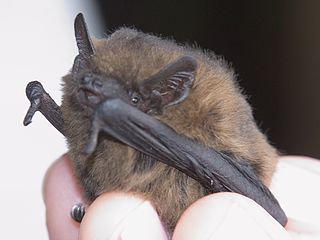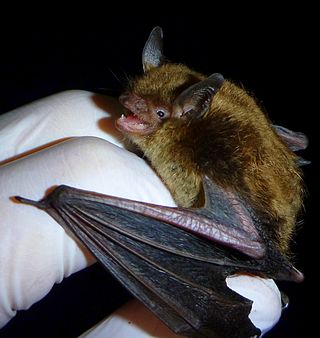
Vespertilionidae is a family of microbats, of the order Chiroptera, flying, insect-eating mammals variously described as the common, vesper, or simple nosed bats. The vespertilionid family is the most diverse and widely distributed of bat families, specialised in many forms to occupy a range of habitats and ecological circumstances, and it is frequently observed or the subject of research. The facial features of the species are often simple, as they mainly rely on vocally emitted echolocation. The tails of the species are enclosed by the lower flight membranes between the legs. Over 300 species are distributed all over the world, on every continent except Antarctica. It owes its name to the genus Vespertilio, which takes its name from a word for bat, vespertilio, derived from the Latin term vesper meaning 'evening'; they are termed "evening bats" and were once referred to as "evening birds".

The New Zealand lesser short-tailed bat is a small-sized omnivorous mammal endemic to the islands of New Zealand. It is one of two extant and three overall terrestrial mammal species unique to New Zealand. Its closest relative, the New Zealand greater short-tailed bat, was last seen in 1965 and is presumed extinct due to intense predation from ship rats introduced in the last few centuries. These bats are also commonly referred to as pekapeka, their Māori-language name. Lesser short-tailed bats have unique adaptations that differentiate them from bats found in other parts of the world. For example, they are fully capable of moving along the ground to search for food, and the males sing to attract partners, taking turns to do so. Lesser short-tailed bats are a vulnerable species, so extensive conservation work and research are being done to prevent extinction.

The big brown bat is a species of vesper bat distributed widely throughout North America, the Caribbean, and the northern portion of South America. It was first described as a species in 1796. Compared to other microbats, the big brown bat is relatively large, weighing 15–26 g (0.53–0.92 oz) and possessing a wingspan of 32.5–35 cm (12.8–13.8 in).

Natterer's bat is a European vespertilionid bat with pale wings. It has brown fur tending to greyish-white on its underside. It is found across most of the continent of Europe, parts of the Near East and North Africa. It feeds on insects and other invertebrates which it catches on the wing or pursues on the ground.

The common pipistrelle is a small pipistrelle microbat whose very large range extends across most of Europe, North Africa, South Asia, and may extend into Korea. It is one of the most common bat species in the British Isles. In Europe, the northernmost confirmed records are from southern Finland near 60°N.

The greater noctule bat is a rare carnivorous bat found in Europe, West Asia, and North Africa. It is the largest and least studied bat in Europe with a wingspan of up to 46 centimetres (18 in) and is one of the few bat species to feed on passerine birds. Greater noctule bats are the only bat species to hunt birds on the wing rather than when roosting. The greater noctule bat has wings adapted for open-air hunting and uses echolocation frequencies above the hearing range of birds.

The soprano pipistrelle is a small species of bat. It is found in Europe and often roosts on buildings.

The greater bamboo bat is a species of vesper bat in the family Vespertilionidae. It is found in Cambodia, China, India, Indonesia, Laos, Malaysia, Myanmar, the Philippines, Singapore and Thailand.

The banana serotine, formerly known as the banana pipistrelle, is a species of vesper bat found throughout much of Africa. It was previously known as Pipistrellus nanus, but genetic analysis later reclassified it in Neoromicia. However, more recent phylogenetic evidence indicates that it and Heller's serotine comprise the distinct genus Afronycteris.

The golden-tipped bat is a species of Microchiropteran in the family Vespertilionidae. It is found in Papua New Guinea and in Australia, especially scattered along the eastern part of Australia. The species is considered uncommon, and is listed as endangered in Australia.

The Indian roundleaf bat, also known as the large Ceylon leaf-nosed bat or Kelaart's leaf‐nosed bat is a species of bat in the family Hipposideridae. It is endemic to the Indian subcontinent, with marginal populations also detected in Southeast Asia. Its natural habitats are subtropical or tropical dry forests and caves. The bat has three subspecies that occur in India, Sri Lanka, and Myanmar. The Indian subspecies, H. l. indus, is smaller than the ones found in Sri Lanka and Myanmar, although there are no other characteristics that differentiate the subspecies.

Ansorge's free-tailed bat is a species of bat in the family Molossidae native to sub-Saharan Africa. It is named for W.J. Ansorge, who collected the first formally described specimen.

Wahlberg's epauletted fruit bat is a species of megabat in the family Pteropodidae. It is commonly found across southern Africa.

Sundevall's roundleaf bat, also called Sundevall's leaf-nosed bat, is a species of bat in the family Hipposideridae.

The Madagascar sucker-footed bat, Old World sucker-footed bat, or simply sucker-footed bat is a species of bat in the family Myzopodidae endemic to Madagascar, especially in the eastern part of the forests. The genus was thought to be monospecific until a second species, Myzopoda schliemanni, was discovered in the central western lowlands. It was classified as Vulnerable in the 1996 IUCN Red List of Threatened Species but is now known to be more abundant and was reclassified in 2008 as of "Least Concern".

The little brown bat or little brown myotis is an endangered species of mouse-eared microbat found in North America. It has a small body size and glossy brown fur. It is similar in appearance to several other mouse-eared bats, including the Indiana bat, northern long-eared bat, and Arizona myotis, to which it is closely related. Despite its name, the little brown bat is not closely related to the big brown bat, which belongs to a different genus.

The bamboo bats are genus of vesper bats in the genus Tylonycteris. The name translates as "padded bat", and refers to the presence of hairless fleshy pads on the hands and feet, which the bats use to help them grip onto bamboo.
The pygmy bamboo bat is a species of vesper bat in the family Vespertilionidae. It is found in Southwest China and was discovered in 2007. The species is around 4 cm (1.6 in) long and weighs between 2.6 and 3.5 g.

Vespertilionini is a tribe of bats in the family Vespertilionidae. The largest of the tribes in Vespertilioninae, it contains many genera found throughout the Old World and Australasia.
Ward's long-eared bat is a species of vesper bat in the family Vespertilionidae. It is found in mountainous regions of South Asia and adjoining regions.




















